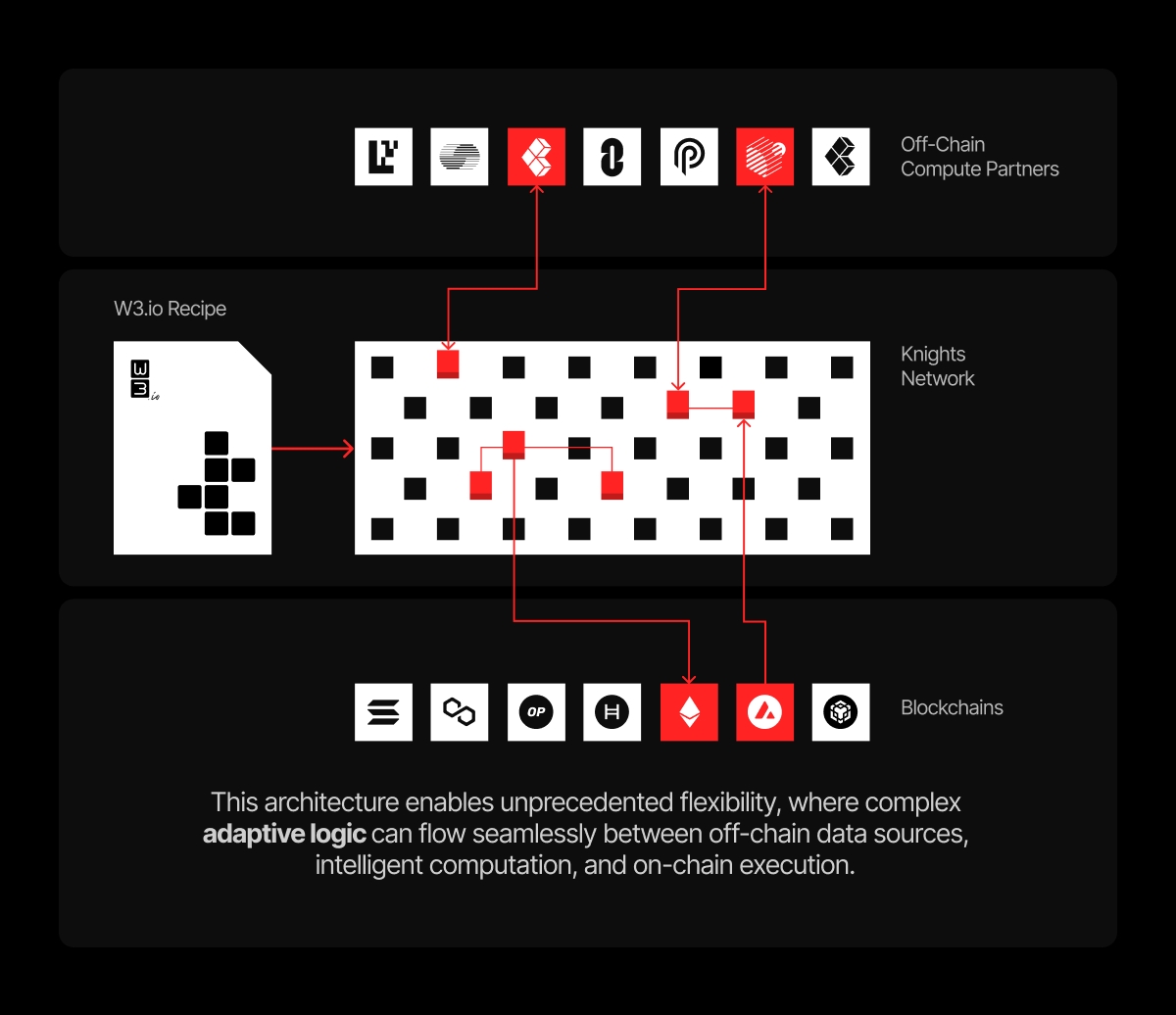Protocol Architecture
What is W3.io?
W3.io is a decentralized coordination network that bridges blockchain's on-chain execution capabilities with off-chain computational power. While Oracles focus on verifiable data feeds (2D), W3.io enables verifiable workflows that coordinate complex multi-step processes across decentralized infrastructure (3D).
Unlike traditional blockchains, W3.io is not an L1. Instead, we operate a specialized network of nodes that act as intelligent coordinators, executing "recipes" (workflows) that combine multiple "ingredients" (network partners' services) into complete business solutions.
Key Differentiators:
Programmable Intelligence: Smart contract systems that can "think, adapt, and act" through AI-driven logic
Cross-Chain Coordination: Native interoperability across multiple blockchain networks
Verifiable Workflows: End-to-end cryptographic verification of complex multi-party processes
Partner Ecosystem: 60+ integrated decentralized compute and middleware providers
W3.io's Prodigy Network represents a paradigm shift in blockchain infrastructure, creating what we call "programmable intelligence" — a seamless bridge between off-chain compute resources and on-chain execution. Our architecture enables unprecedented flexibility where complex adaptive logic can flow seamlessly between off-chain data sources, intelligent computation, and on-chain execution.

Off-Chain Compute At the top tier, our extensive network of over 60+ decentralized compute partners provides specialized services ranging from AI inference to data verification. Unlike traditional approaches that rely on centralized services (costing web3 projects approximately $180 million annually), our architecture leverages decentralized alternatives that maintain the core ethos of web3 while providing enhanced capabilities.
These partners represent the best-in-class for their respective specialties, carefully selected based on their commitment to decentralization and their ability to solve specific business problems. By integrating them directly into our protocol, we demonstrate the same trust in decentralized solutions that we advocate to our customers.
Knights Layer The middle tier consists of our Knights network — decentralized nodes that execute W3.io recipes. These nodes operate based on a uniform core code structured as an event-driven finite state machine, optimized for efficiency and reliability. Knights come in three varieties to accommodate diverse computing resources:
High Availability Nodes: Equipped with advanced compute resources including TEEs, GPUs, and high-performance CPUs, targeting 99.999% uptime.
Normal Nodes: Similar to desktop computers with consistent but occasionally interrupted connectivity.
Community Nodes: Devices with intermittent availability that can contribute during periods of non-use.
Unlike other systems that require costly specialized hardware, W3.io lowers barriers to entry, allowing individuals to contribute with existing devices, while still accommodating professional node operators. All nodes, regardless of category, participate as consensus peers within the network, executing the ingredients assigned to them.
Blockchains The foundation tier connects to multiple L1/L2 networks, allowing smart contracts to be executed on the customer's blockchain of choice. This native cross-chain compatibility ensures that W3.io can interact with any blockchain ecosystem, providing flexibility and future-proofing for our customers.
How The Layers Interact
When a recipe is triggered (shown by the red path in the diagram), the Knights network orchestrates the entire workflow:
The recipe file defines the business process to be executed.
Knights coordinate to execute each step in the recipe.
When off-chain computation is needed, Knights securely interface with the appropriate compute partners.
When on-chain actions are required, Knights interact with the specified blockchains.
Throughout execution, all operations are logged and cryptographically verified.
This architecture solves the critical challenges identified in our whitepaper:
Reducing dependence on centralized services by creating a decentralized alternative.
Simplifying technical integration by orchestrating complex workflows across multiple providers.
Addressing business challenges by providing a unified framework with established partnerships and single pane of glass payments.
Verification and Consensus
Every recipe execution follows this verification flow:
Trigger Detection: Multiple nodes detect and verify the triggering event
Consensus Formation: Selected nodes reach agreement on execution parameters
Step-by-Step Logging: Each ingredient execution is hashed and logged
Merkle Tree Aggregation: Completion hashes are aggregated into Merkle trees
On-Chain Recording: Merkle roots are recorded on customer's preferred blockchain
Persistent Storage: Full logs stored on decentralized storage for long-term verification
Consensus without an L1
Our unique challenge: achieving consensus about work completion and rewards without building a full blockchain.
Solution: Recipe-level consensus with distributed execution
Each recipe runs on a subset of nodes based on consensus requirements
Nodes participate in consensus for their assigned recipes
Results are cryptographically verified and recorded on customer's preferred chain
Network maintains coordination state without global blockchain overhead
Last updated